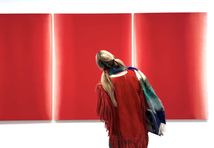A Review of ‘A Heritage of Images’ by Fritz Saxl
- The Courtauldian
- Nov 15, 2015
- 3 min read

When one thinks of the books section of a paper, the literature you imagine to be discussed is probably fiction. However we all attend an academic institution dealing with works of non-fiction so, for this article, we shall concern ourselves with a brilliant yet seemingly forgotten book by a brilliant and seemingly forgotten Art Historian: Fritz Saxl.
Saxl, as one can tell from the book, was obviously a vociferously intelligent man. He trained under Dvorak, who had been Riegl’s favourite pupil, and later finished his studies under the acclaimed Formalist Heinrich Wolfflin. He worked as an intellectual aide to Warburg and, later, Panofsky and was close friends with Gombrich. Saxl is most associated with Aby Warburg, the brilliant yet personally troubled man who gave his inheritance of a Hamburg bank to his younger brother at the age of fourteen in return for whatever books he desired. Warburg was, as Caroline Cernia Slovin put it; ‘obsessed by Art’ an obsession which would take him from the deserts of the Sierra Nevada to Florence and Rome to sate his appetite for knowledge. Saxl accompanied Warburg on most of his trips and even filled in the role as general administrator of Warburg’s affairs when the older academic had his frequent turns of manic depression. The last bout of which left him in the Kreuzlingen Sanitorium for three years from 1921-1924. Warburg’s work on the nature of civilisation, its evolution over time and the place of images at the heart of that history, all feeds into Saxl’s work. After Warburg’s death in 1929, Saxl worked tirelessly to take his colleague’s library, his life’s work, out of Nazi Germany and over to Britain. Once installed in Bloomsbury Saxl turned the library into a research institute, a stroke of brilliance which even Warburg hadn’t considered.
Saxl lived through the war (despite an anecdote which Gombrich relates where he carried on reading a map of seventeenth century Amsterdam so as to better understand Rembrandt, despite the fact there was an air raid on) and died in 1948 after overworking himself to complete Warburg’s work and run the institute.
A Heritage of Images is a book of posthumously compiled essays and lectures written and delivered at the Warburg Institute. The book starts with an essay entitled ‘Continuity and Variation in the Meaning of Images’ which gives a wonderfully cogent argument exploring the central concerns of iconography through three examples of image types and how they evolve over time. The book, in the way it is constructed after that, gives a detailed analysis of the reintroduction of Classicism back into Western Art from the end of the Roman era to the Reformation briefly wandering into the eighteenth and nineteenth-centuries to discuss Watteau and Cézanne.
Saxl is a beautifully eloquent writer and conveys dense concepts with consummate ease. While he produced more than these eight essays, this book is a perfect introduction to the man’s thought as he subtly revised Warburg’s theories on the evolutionary nature of culture. He did this to show that the Apollonian and Dionysian urges of civilisation can exist in tandem and are not progressive from one another.
In conclusion, Fritz Saxl was a brilliant art historian and a brilliant mind who, due to his shyness and unwillingness to force his personality, has been largely forgotten. But, this is a book worth reading for any art historian as it isn’t didactic or polemical. In Saxl’s own words: ‘I would rather give no answer than present a short unjustified formula; and I shall be quite content if you feel that I have presented some facts clearly…I shall be only too glad if any of you can help me to define the problem more closely.’












Comments